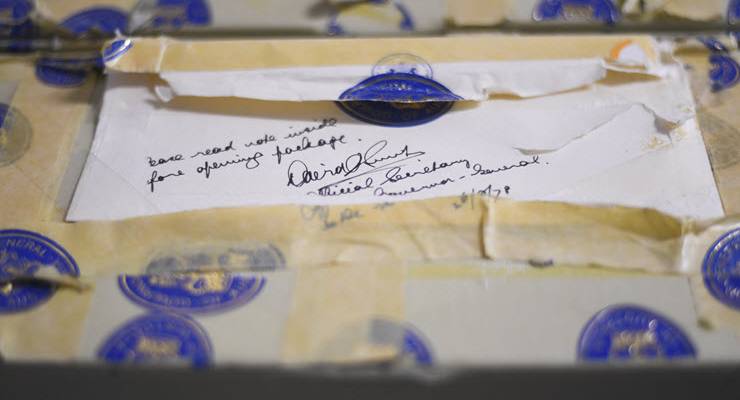
On Tuesday, the Palace Letters revealed the behind the scenes footage from the Whitlam dismissal.
Whitlam nostalgia and republicanism could be starting to make a real comeback.
But the letters also shed a bit of light on an eccentric assortment of characters, some familiar, others forgotten beyond high school history lessons.
Here’s a quick refresher on the Dismissal’s main dramatis personae.
Sir John Kerr
There’s something faintly tragicomic about the narrative arc of Kerr, the working class lad who scrapped his way to Yarralumla only to be forever immortalised as the villain of the Dismissal.
Born to a family of dock-workers in pre-gentrification Balmain, pulled himself up by his bootstraps all the way to the NSW Supreme Court, where he was the chief justice. Whitlam picked Kerr for governor-general because he was, at least once, a solid Labor man, a protegee of former leader H.V. “Doc” Evatt.
Whitlam was wrong. Kerr lived his post-dismissal life as a pariah.
His drinking problem, already known in judicial circles before his appointment as governor-general would worsen, and put him in hospital twice. Two years after the Dismissal, Kerr, buffoonish and sloshed out of his mind, gave a rambling speech at the Melbourne Cup to a chorus of jeers.
That was how Kerr would be remembered — a figure of ridicule Whitlam would compare to Roman emperor Caligula, who made his horse a consul.
Gough Whitlam
Whitlam’s fate couldn’t be further from Kerr’s.
He’s still dearly beloved, and not even a landslide electoral loss after the dismissal could change that. Remembered as the prime minister who brought Australia into the 20th century, Whitlam’s death in 2014 triggered an outpouring of goodwill from both sides of politics.
Sir Martin Charteris
Martin Michael Charles Charteris, Baron Charteris of Amisfield was just the kind of Eton-educated toff you’d expect to be Her Majesty’s lackey-in-chief.
Charteris, who praised Kerr for NOT informing the Queen of the Dismissal, left his job as private secretary to become provost of Eton two years later.
In 1976, Charteris dined with Whitlam, and wrote to Kerr that the former prime minister had “at least conceded” that Kerr may have acted in accordance with the Constitution.
Charteris got to see a lot, and would later speak his mind. In a 1995 interview with The Spectator, he unloaded — calling Prince Charles “whiny” and comparing the Queen Mother to an “ostrich.”
Sir William Heseltine
Queen Elizabeth II’s assistant private secretary at the time, Heseltine helped break the news of the Dismissal.
He’s had quite the career, serving in a number of roles in the palace, most notably as the Queen’s private secretary from 1986 to 1990.
He’s also well-connected in Australian Liberal circles — working for Robert Menzies, and as the party’s assistant federal director before heading to London.
When he left Canberra, Menzies signed a photo for him dedicated admiringly to his “old slave.”
Turning 90 today, Heseltine told The Australian that if Kerr had have held his nerve for a couple of days, a political solution would’ve been found, “which would have avoided a lot of fuss”.
Sir Garfield Barwick
The Palace Letters shed a little more light on the role played by the then-High Court chief justice, who gave Kerr a little “off the record” advice on the constitutionality of the Dismissal, an issue that could easily have ended up before the court.
Barwick’s position on the dismissal shouldn’t come as a surprise — before heading to the bench he was a Liberal MP and attorney-general, once tipped to be Menzies’ successor.
Barwick wouldn’t speak of his role in the Dismissal until his 1995 autobiography, where he downplayed the extent of his conversations with Kerr. The title of that book? The Radical Tory.
Paul Kelly
Not the singer, or the deputy chief medical officer, but the former editor-in-chief of The Australian.
Kelly was on the front page of the paper in 1975 — he’d become the Oz’s chief political correspondent a year earlier.
On Tuesday, he was back on the front page writing about the Palace Letters, as editor-at-large.
Since the Dismissal, he’s written a couple of books about it, and largely followed the paper’s rightward drift.
He was critical of same-sex marriage, says progressive elites are destroying liberalism, and rails against virtue signalling.
Queen Elizabeth II
She was just 23 years into her reign when Whitlam was dismissed.
Now she’s Britain’s longest-serving monarch, and doesn’t seem to be going anywhere. Meanwhile, the monarchy has never been more popular in Australia.








Crikey is committed to hosting lively discussions. Help us keep the conversation useful, interesting and welcoming. We aim to publish comments quickly in the interest of promoting robust conversation, but we’re a small team and we deploy filters to protect against legal risk. Occasionally your comment may be held up while we review, but we’re working as fast as we can to keep the conversation rolling.
The Crikey comment section is members-only content. Please subscribe to leave a comment.
The Crikey comment section is members-only content. Please login to leave a comment.